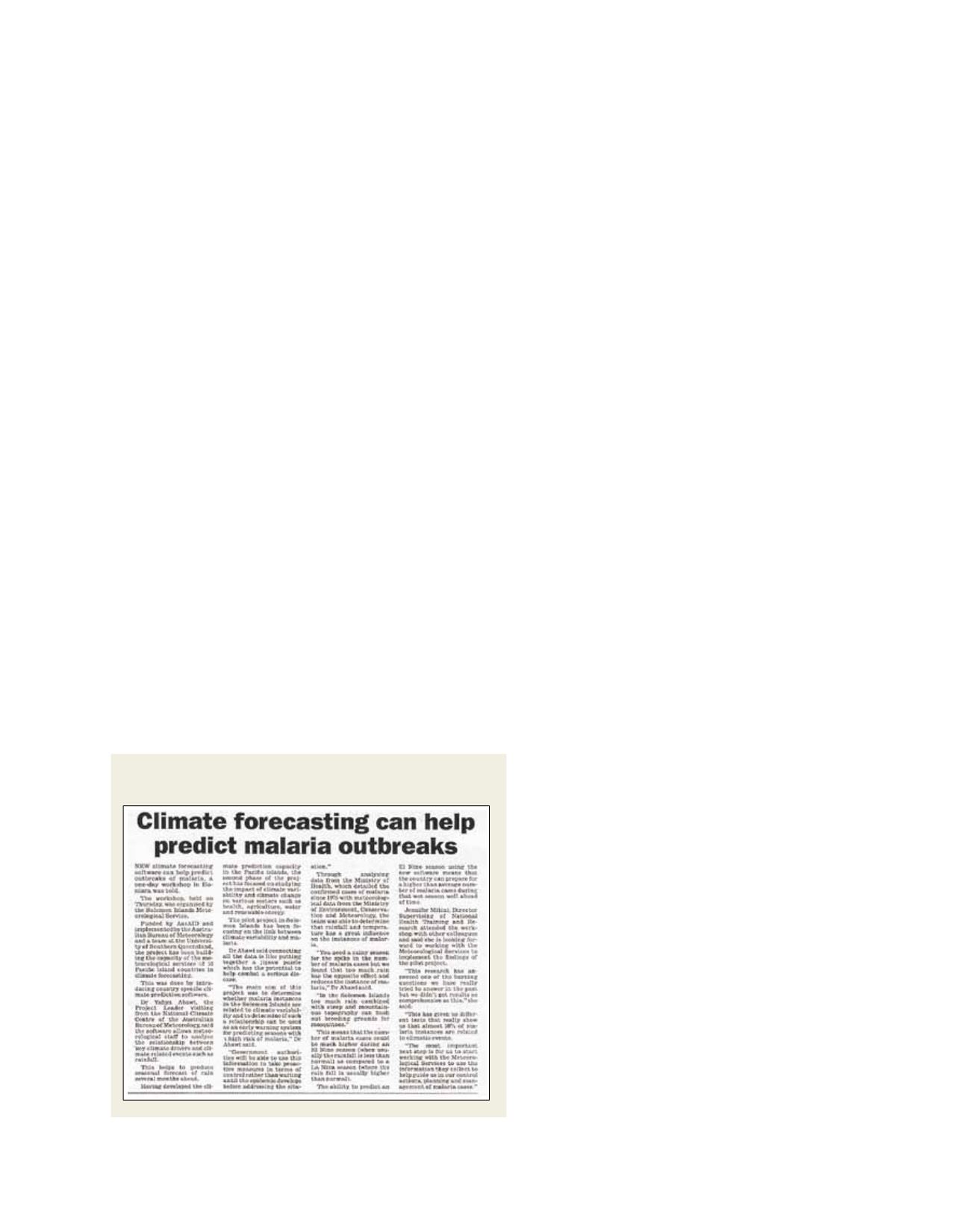

[
] 104
H
ealth
Use of climate information
A prime example of the use of climate information to facili-
tate improvements in malaria management is the Malaria Early
Warning System (MEWS) developed in Sub-Saharan Africa over
the last decade by the Roll Back Malaria partners under the
auspices of the World Meteorological Organization.
3
With the
confirmation of a robust relationship between ENSO phenomena
and malaria incidence in the Solomon Islands, the development
of a similar early warning system for the Solomon Islands is
considered feasible.
An operational early warning system will require the establish-
ment of a number of protocols and procedures for ensuring the
rapid and timely exchange of information between the NMS and
relevant health providers, as well as an effective means of inform-
ing key Government entities and the wider population. The end
results will be improved healthcare outcomes for the residents of
the Solomon Islands and a more appropriate provision of health
services during periods of high malaria incidence, thus improving
the standard of care, the quality of healthcare outcomes, and cost
savings due to more efficient use of resources. These improvements
will likely lead to benefits in the overall wellbeing of the local popu-
lation, particularly during periods of high malaria risk and infection
potential. They will also bring long-term benefits to work and educa-
tion output (due to reduction in lost productivity from illness and
incapacity), as well as improvements to quality of life, subjective life
satisfaction and possibly average life expectancy.
Outreach
This project has been a pioneering case study of the impact of
climate variability and possible climate change on the health
of a Pacific community. Although the study has focused on the
Solomon Islands, the methodology has wider applications in a
number of other Pacific Island nations for improving the manage-
ment of malaria in Papua New Guinea and Vanuatu, dengue fever
in Fiji, and waterborne pathogens in Kiribati. Contrary to the
common belief that higher rainfall in the tropics is
generally conducive to a higher incidence of malaria,
this study has concluded that a certain rainfall thresh-
old, if exceeded, can significantly reduce the incidence
of malaria. It is not clear whether direct extrapolation
of the results of this study to other regions is appro-
priate, due to substantial differences in the effects of
the ENSO cycle on different PICs and to variations
in topography and geography across the region, all
of which can significantly affect the epidemiology of
climate-related illnesses.
The results of this research were presented in a work-
shop in Honiara and received wide coverage in local
media and an interview on the ABC Pacific Channel
with Lloyd Tahani of the Solomon Islands NMS. The
project has raised the profile of the NMS in the Solomon
Islands and has fostered closer collaboration between it
and health service organizations in the country.
Towards a sustainable system
Following the Honiara workshop, Dr Jennifer Mitini,
Director of National Health Research and Training, said
in an interview:
“The research has answered one of the burning ques-
tions we have really tried to answer in the past, but we
didn’t get results as comprehensive as this [study]. The
most important next step is for [the health commu-
nity] to start working with the Meteorological Services
to use the information they collect to help guide us
in our control actions, planning and management of
malaria cases.”
An early warning system for malaria has enor-
mous potential, from a public health perspective,
to be a very valuable tool in reducing the spread of
malaria in the population of the Solomon Islands,
and possibly other PICs. It is important that any
early warning system be sustainable once external
resources are removed. Experience in other develop-
ing countries has shown that the implementation of
simple and reliable alert systems can be a better use
of resources than trying to develop very costly and
complex model-based systems.
4
This pilot project has
demonstrated that it is possible to produce malaria
alerts based on seasonal climate forecasts issued by
SIMS and that this information could be provided
to the authorities and general public to complement
existing control strategies and policies.
The direct link between the outcomes of this study
and the Millennium Development Goal of a way of
reducing the incidence of malaria poses distinct advan-
tages for the future developments of an alert system
in the Solomon Islands and other PICs. With respect
to the Solomon Islands, the advantages are three-
fold. Firstly the commitment to the goal of malaria
reduction is already a well-established policy for
both the Solomon Islands Government and interna-
tional donors. The Solomon Islands Government has
been heavily engaged in malaria reduction for several
decades. Its commitment to reduction strategies has
The PI-CPP Solomon Islands pilot project received wide
coverage in the local media
Source:
Solomon Star,
1 August 2009
















